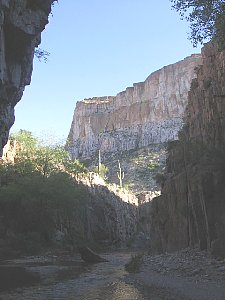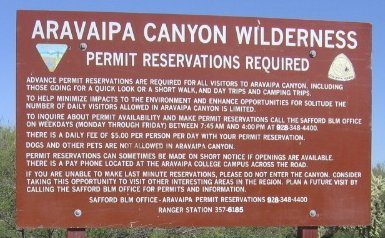Permits
Good news! The Grand
Enchantment Trail is mostly free of beauracratic red tape. The only permits you'll
need are two: an Aravaipa
Canyon Wilderness permit, allowing access to this scenic canyon which our
route traverses ($5 per person per day; a one or two
day traverse for most hikers), and the other to cross Arizona
state trust land ($15 per person or $20 for a family,
good for one year).
Aravaipa
Canyon Wilderness permit system
In
order to protect Aravaipa Canyon's unique and fragile ecosystem, the BLM Safford
field office limits visitation to 50 people per day, 30 of whom may enter the
wilderness from the west end, and 20 via the east entrance. (No
pets or mechanized equipment are allowed in the Wilderness permit zone; a limited
number of pack animals are allowed for day use only, not overnight.) Spring and
fall are popular seasons at Aravaipa, particularly on weekends, and permits are
often sold out well in advance, so it's advisable to reserve as far ahead as practical.
Permits are available
up to 13 weeks in advance, and can ONLY be reserved
online at recreation.gov (NOT in person and NOT at the ranger station or trailheads).
Permits cost $5 per person per day in the canyon; you're simply paying for daily
access here, such that to camp within the wilderness you'll need a minimum 2-day
permit. Example: Traversing the entire canyon in a day (not camping within it)
requires a one-day permit; traversing it over the course of two days (therefore
camping within it) requires a two-day permit, and so forth.
 |
| Aravaipa
Canyon Wilderness |
Of
particular note to G.E.T. thru-hikers, Aravaipa Canyon Wilderness permits are
date-specific and non-adjustable after purchase, so you'll want to give the matter
some thought. Here are some suggestions:
Eastbound
Springtime
hikers heading east will reach Aravaipa during its busiest season, so ideally
would have bought their permits as far in advance as possible. You'll enter Aravaipa
Canyon Wilderness via its western end and thus need secure a permit for this trailhead.
The Aravaipa west trailhead lies approximately 130 miles from the G.E.T.'s terminus
near Phoenix, or ~80 miles from the town of Superior. Based on these mileages,
eastbound hikers in planning can estimate how long it will take to reach Aravaipa
Canyon, then choose permit date(s) accordingly. Try your best to start your hike
according to schedule, and consider giving yourself a day or two of leeway to
account for any daily mileage shortcomings. You might also consider trying to
get a permit for two days in the canyon even if you think you'll cross it in a
single day; this way if you don't manage to arrive on Day 1 as planned, you can
traverse the full Wilderness permit zone on Day 2 instead.
Westbound
Westbound
thru-hikers will reach the east entrance of Aravaipa Canyon toward the end of
their journey, so would find it impractical to reserve date-specific permits before
the thru-hike. Instead, wait until you reach the town of Clifton/Morenci (~145
miles from Aravaipa) or Safford (~85 miles), then go online to obtain a permit
for the east trailhead. Most westbound hikers arrive well into the autumn season
when Aravaipa tends to see less use, so in most cases obtaining a permit is not
quite as difficult. Still, on occasion you may or may not get the precise date(s)
you'd prefer. But a day or two of waiting around probably wouldn't be the end
of the world, either.
Length
of Stay
Eastbound
or west, most long-distance hikers will probably want to spend a night in the
Wilderness itself if possible, even though the rugged 10 mile length of the canyon
here is traversable in a (fairly long) day. This, of course, means reserving a
two-day permit. Otherwise, hikers could camp at Brandenburg campsite (free, first-come
first-served) 3 miles outside the permit zone on the west side, or in the canyon
of Turkey Creek on the east side, thus reserving only a one-day permit for the
canyon - a potential advantage when availability is limited.
Alternatives
So
you tried your level best but couldn't quite manage to show up on the correct
date. What to do?
The
short answer is this: Don't enter the Wilderness permit zone unless you have a
permit with the correct date(s) and entry trailhead shown. There is no legal way
through the canyon otherwise. The BLM ranger regularly patrols the Wilderness
and access roads, and hikers have been and WILL be fined for breaking the rules.
Further, the ranger is unable to issue permits or to change permit dates for you--no
exceptions are granted for G.E.T. hikers (regardless of what may have been the
case in the past), so please don't show up asking for favors. Here's how to do
the right thing instead:
Make
sure you've chosen your permit date(s) wisely in advance. Watch the online permit
calendar well before your planned arrival in order to ensure best availability.
Springtime hikers in particular should treat the process like trying to get concert
tickets: figure out your arrival date over the winter then hit up the reservation
system the very day your date becomes available (this is to say, 13 weeks / 91
days before your anticipated arrival date). You might also consider trying to
get a permit for two days in the canyon even if you think you'll cross it in a
single day; this way if you don't manage to arrive on Day 1 as planned, you can
traverse the full Wilderness permit zone on Day 2 instead. Now, during your hike,
keep up your planned daily mileage with Aravaipa fully in mind. Hopefully this
mindful approach works and you get to experience the majesty of Aravaipa. If,
however, you reach your last town stop before Aravaipa and you're hopelessly off-schedule,
then see about cancelling your permit and purchasing a new permit for your new
arrival date. Long odds, perhaps, but worth a shot since people do sometimes cancel
last-minute. Otherwise...
Luckily
the GET offers two alternate routes that circumvent the Wilderness area and with
it all permit-related concerns. (Refer to guidebook chapter
6 and chapter 7 [Aravaipa Canyon Bypass and
Aravaipa Canyon Bypass North] for more information on these two scenic alternatives
and how their mileages differ from the main route through Aravaipa Canyon itself.
Is either alternate route as good as the classic Aravaipa Canyon experience? Admittedly
no, and it's disappointing, we understand. But both routes have been successfully
hiked by GET'ers over the years, and each does offer its charms. The northern
alternate, in particular, affords the opportunity to walk out to Aravaipa's sheer-walled
rim from above and peer down into the canyon--a unique perspective few ever experience,
and one that surely whets the appetite to return for the main course in the future,
perhaps off-season and not under the time pressure of a long-distance hike.
Please refer to Segment
7 of the GET Guidebook for more information about Aravaipa Canyon Wilderness
and permit-related logistics.
 |
| Pay
to Play: signboard along Aravaipa Rd tells the story. |
Permit to cross Arizona
State Trust Land
The
Grand Enchantment Trail occasionally crosses state trust lands while winding its
way through the photogenic state of Arizona. The Arizona State Land Department
reminds the traveling public that, alas, state trust land is not public land,
at least not in the usual sense (BLM and Forest Service lands, in contrast, are
under federal jurisdiction, owned by all Americans, and thus are freely open to
the public with limited exception). In order to legally cross state-owned land
-- the familiar blue-shaded sections on land-ownership maps -- you'll need an
ASLD
recreation permit. These permits are good for an entire year and entitle you
(as a GET non-motorized user) to travel on said lands, as well as to camp (so
long as you do so well away from water sources and for no more than 14 days within
a year -- not a problem for GET thru-hikers, as the route doesn't spend all that
much time in state land).
Despite
a widespread lack of enforcement, thru-hikers (as well as section hikers planning
to cross GET segments 5, 6, 8, 9, 11, or 13 *) should get a permit anyway. Not
only will your dollars serve as advocacy for continued recreation access on Arizona
state lands, but they'll also help to support a financially-strapped state government
against leasing or selling more of these parcels to the highest bidder (as has
happened elsewhere).
Annual
recreation permits cost $15 (individual) or $20 (family). Buy your permit online
here.
(* While GET
segments 3 and 4 also cross Arizona state trust land in places, these segments
run concurrently with the Arizona Trail, along which hiking and camping are allowed
without the need for a permit.)





